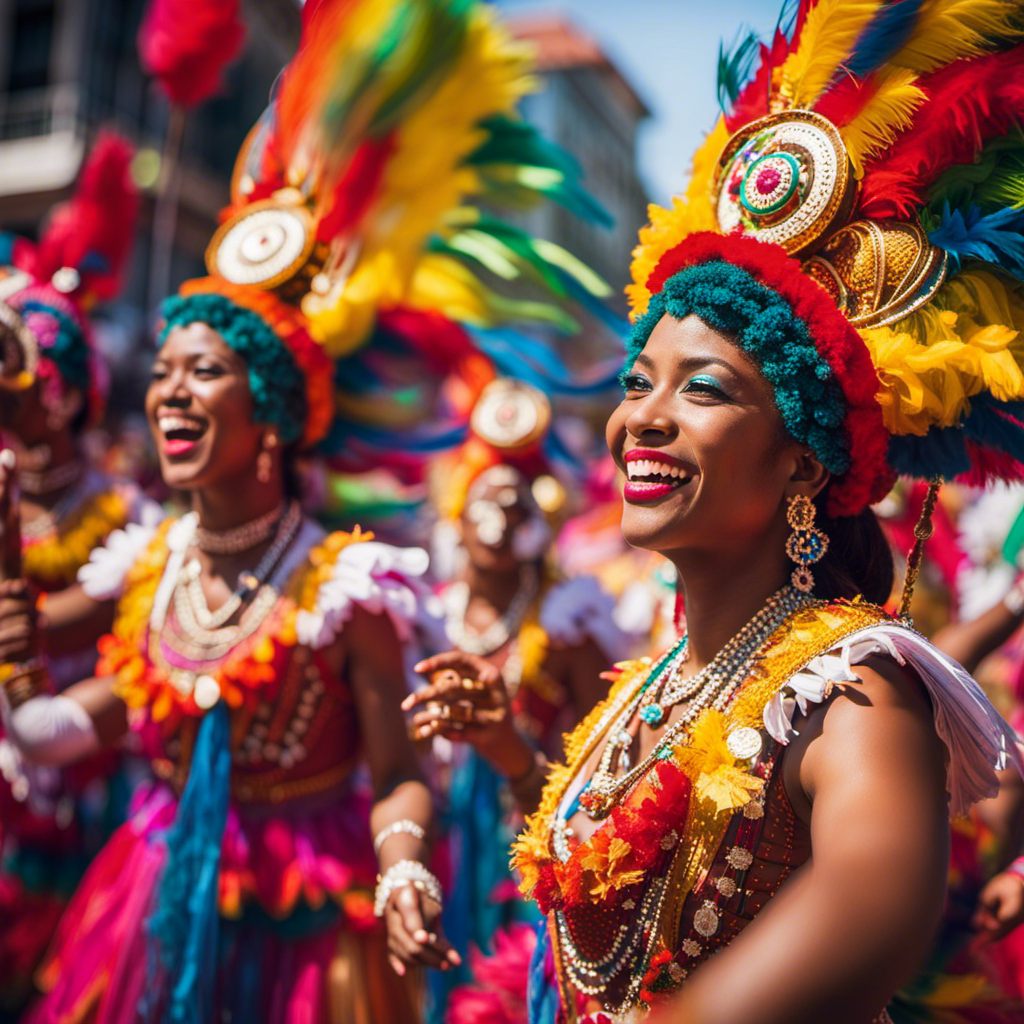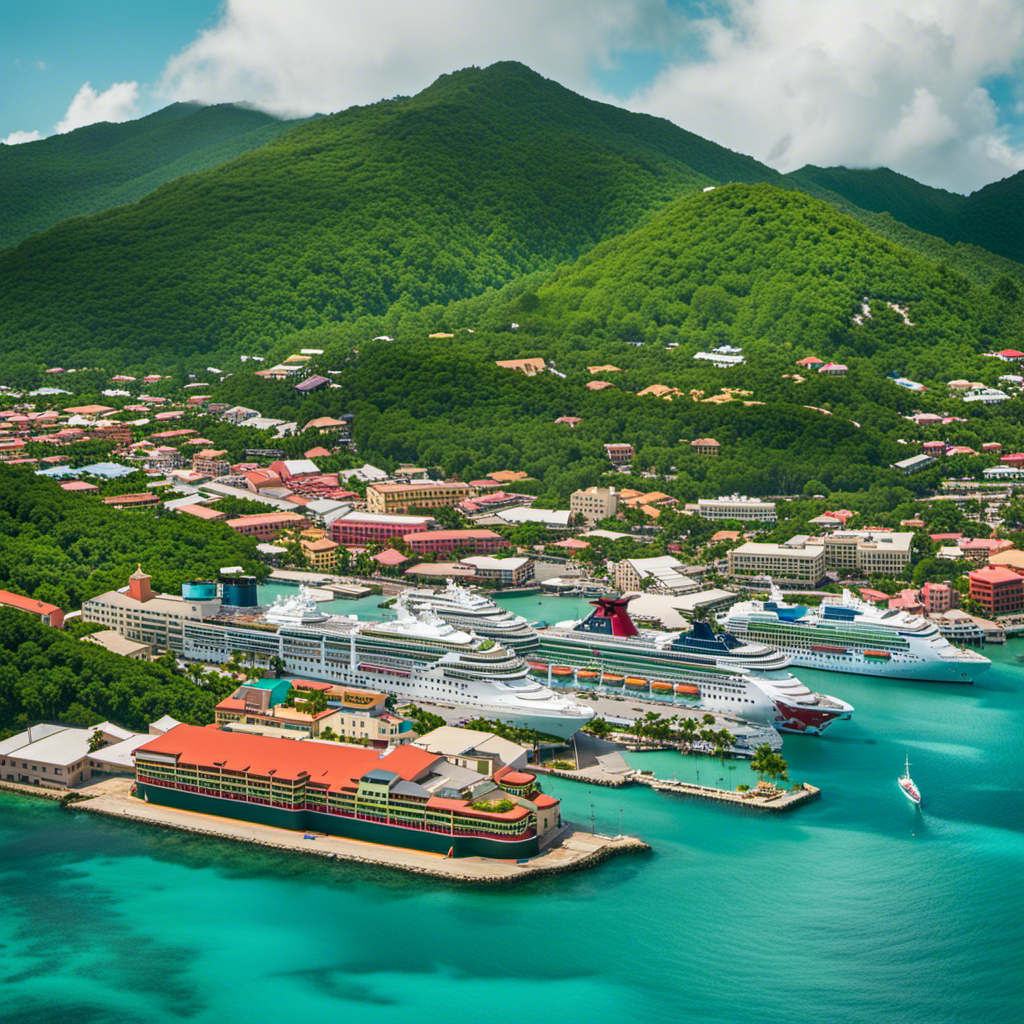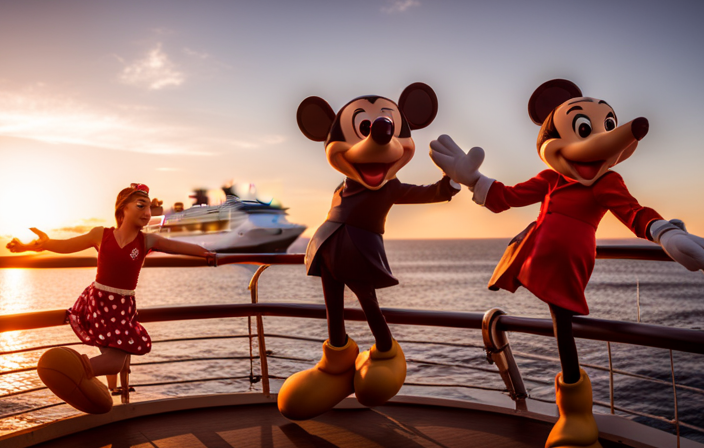The rich and dynamic traditions of carnival celebrations around the world have always fascinated me.
Did you know that the Rio de Janeiro Carnival is the largest and most spectacular carnival celebration, featuring weeks of enormous parades, samba-school competitions, and mind-blowing costumes?
From the Carnevale of Venice to the Trinidad and Tobago Carnival, these festivities bring people together in a whirlwind of music, dance, and cultural blends.
In this article, we will explore the oldest traditions, the spectacular parades, and the fascinating cultural blends that make carnival celebrations so unique.
Key Takeaways
- Carnevale of Venice is the oldest roots of any seasonal celebration and is known for its famous masks and free spirit.
- Rio de Janeiro Carnival is the largest and most spectacular Carnival celebration, with enormous parades, samba-school competitions, and mind-blowing costumes.
- Carnaval de Santa Cruz de Tenerife is the second most popular party after Rio de Janeiro, known for its unique cultural blends, outdoor concerts, and African and Mediterranean influences.
- Trinidad and Tobago Carnival is known for its multi-season celebrations and music genres like calypso, steel pan, chutney, and soca bands, with infectious beats keeping the festivities going.
The Oldest Carnival Traditions: Uncovering Ancient Roots
I’m fascinated by the Carnevale of Venice, which has the oldest roots of any seasonal celebration and is known for its famous masks and the freedom it allows commoners and nobles to mingle freely.
Unearthing ancient customs and exploring the historical significance of this event is truly captivating. It dates back to the 12th century and was initially a time of indulgence before the Christian period of Lent.
The masks worn during the Carnevale have a rich history and were used to conceal one’s identity, allowing people to engage in activities they wouldn’t normally partake in. This celebration was a way for society to temporarily escape social constraints and enjoy misrule.
It is fascinating to see how these traditions have been preserved throughout the centuries, making the Carnevale of Venice a unique and important cultural event.
Spectacular Parade Extravaganzas: A Feast for the Senses
The floats and costumes in these parades are absolutely mesmerizing. Feathers and sequins adorn the elaborate costumes, creating a dazzling display of color and texture. The larger than life floats tower above the crowd, their intricate designs and vibrant colors capturing the imagination. As I stood among the cheering spectators, I couldn’t help but be awestruck by the sheer spectacle before me. To convey the grandeur of these parades, let me present a table that showcases the magnificence of carnival celebrations:
| Carnival Celebration | Location | Highlight |
|---|---|---|
| Rio de Janeiro Carnival | Rio de Janeiro | Mind-blowing costumes and samba-school competitions |
| Carnaval de Santa Cruz | Tenerife | Unique cultural blend and world’s largest outdoor concert crowd |
| Trinidad and Tobago | Port of Spain | Multi-season celebrations and vibrant music genres like calypso, steel pan, soca |
| New Orleans Mardi Gras | New Orleans | Wild street partying, family-friendly parades, and historic parade krewes |
These parades truly transport you to a world of fantasy and celebration, where feathers and sequins sparkle in the sunlight and larger than life floats create a magical atmosphere.
Cultural Blends: Exploring the Fusion of Traditions
Incorporating elements from diverse cultures, these fusion traditions showcase a vibrant and unique blend of customs and practices. Carnival celebrations around the world are not only a time of revelry and merriment, but also a reflection of the cultural influences that have shaped them.
One fascinating aspect of these celebrations is the traditional costumes worn by participants, which often embody the rich history and heritage of the respective regions. From the intricate masks of the Carnevale of Venice to the mind-blowing costumes of the Rio de Janeiro Carnival, these outfits are a visual representation of the fusion of cultural influences.
The Carnaval de Santa Cruz de Tenerife in the Canary Islands, with its African and Mediterranean influences, also showcases a unique blend of traditions. Additionally, the Trinidad and Tobago Carnival features a variety of music genres and multi-season celebrations, highlighting the fusion of different musical traditions.
Through these cultural blends and the incorporation of traditional costumes, carnival celebrations offer a captivating exploration of global diversity.
Musical Rhythms and Dance: The Heartbeat of Carnival
Dancing to infectious rhythms and moving in sync with the beat, participants in these festive events create a vibrant atmosphere that pulsates with energy.
Traditional instruments play a vital role in preserving the sound of carnival. From the booming bass drums to the melodic notes of the trumpet, these instruments add depth and richness to the music, captivating the audience and setting the stage for the lively performances.
The art of carnival performance is brought to life through choreography and costumes. Elaborate dance routines, synchronized movements, and intricate formations showcase the talent and skill of the performers. Colorful costumes adorned with feathers, sequins, and beads create a visual spectacle that is both captivating and mesmerizing.
Together, the traditional instruments, choreography, and costumes form the heart and soul of carnival celebrations, captivating audiences and creating a truly unforgettable experience.
Carnival Celebrations Across the Globe: Uniting Cultures in Festivity
Attending various Carnival celebrations around the world has allowed me to witness the beautiful way different cultures come together in festive unity. These celebrations hold a deep historical significance and serve as a platform for cultural exchange.
Through the impact of globalization, Carnival traditions have evolved and adapted, creating a vibrant tapestry of diversity and creativity.
-
Historical Significance and Cultural Exchange:
Carnival celebrations have roots that date back centuries, with each region adding its own unique traditions and customs. These celebrations provide a space for cultural exchange, where people from different backgrounds can learn from and appreciate each other’s traditions. -
Impact of Globalization on Carnival Traditions:
Globalization has both preserved and transformed Carnival traditions, as new influences and ideas merge with traditional practices. The exchange of costumes, music, and dance styles has enriched Carnival celebrations, creating a global fusion of cultural expressions.
Through these celebrations, we can witness the power of cultural unity and the ability of Carnival to transcend borders and bring people together in joyous harmony.
Frequently Asked Questions
How Did the Tradition of Wearing Masks During Carnival Celebrations Originate?
The tradition of wearing masks during carnival celebrations originated from the need to break social barriers and allow commoners and nobles to mingle freely. Over time, it evolved into a symbol of misrule and indulgence. History and evolution of this tradition are fascinating.
What Are Some of the Most Unique and Extravagant Costumes Seen at the Rio De Janeiro Carnival?
Extravagant costumes at the Rio de Janeiro Carnival showcase a vibrant fusion of cultural influences. From shimmering sequins to elaborate feathered headdresses, the costumes are a mesmerizing display of creativity that captures the essence of this spectacular celebration.
How Do the African and Mediterranean Influences Contribute to the Unique Flair of the Carnaval De Santa Cruz De Tenerife?
African and Mediterranean influences in Carnaval de Santa Cruz de Tenerife create a cultural fusion that adds a unique flair to the celebration. Traditional music and dance showcase the rich heritage and vibrant energy of these diverse cultures.
What Are the Three Seasons Dedicated to Carnival in Trinidad and Tobago, and What Are the Key Elements of Each Season?
In Trinidad and Tobago, Carnival is celebrated through three seasons: Pre-Lenten, Dimanche Gras, and Carnival Monday and Tuesday. Each season brings parades, costumes, and contests, accompanied by vibrant Carnival music and traditional dances.
What Is the History and Significance of the Masquerade Ball Tradition in New Orleans Mardi Gras?
The masquerade ball tradition in New Orleans Mardi Gras has a rich history and cultural significance. Originating from European carnivals, it allows people to hide their identity and indulge in wild festivities. Masks symbolize freedom and celebration.










